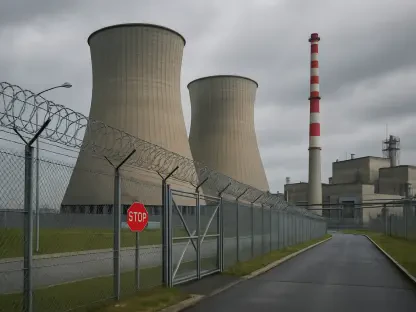The groundbreaking adoption of synthetic aviation turbine fuels (SATFs) in Norwegian F-35 fighter jets marks a significant milestone in military aviation. This pivotal development represents not only an evolution in the types of fuels used by advanced military aircraft but also underscores a broader commitment to sustainability and operational readiness among military forces. As the world grapples with the harsh realities of climate change, military forces are now taking unprecedented steps towards reducing their carbon footprint without compromising on performance. The successful integration of SATFs in the F-35 program showcases the potential of green alternatives in high-stakes environments and sets a compelling precedent for future innovations.
The implications extend beyond mere environmental concerns. As global supply chains face increasing volatility due to geopolitical tensions and other disruptions, the ability to diversify fuel sources emerges as a crucial strategic advantage. The envisaged operational flexibility and resilience in the fuel supply chain for F-35 jets are poised to offer compelling advantages. By permitting a 50% blend of synthetic and conventional jet fuels, Lockheed Martin is not only future-proofing the F-35 but also significantly enhancing its capability to conduct extended missions unperturbed by conventional supply constraints.
The Shift to Synthetic Fuels
Lockheed Martin, the renowned manufacturer of the F-35 Lightning II, has given the green light for integrating SATF into the aircraft, signaling a transformative shift in fuel reliance. This approval paves the way for F-35 jets to operate with fuel blends that include up to 50% synthetic fuel mixed with conventional jet fuel, depending on the raw materials and production methods used. This development allows for greater flexibility and resilience in the fuel supply chain, significantly enhancing the operational readiness and independence of the F-35 fleet. Norwegian F-35s at Ørland Air Station have already completed their inaugural flight using SATF, marking a historic first both for Norway and the F-35 program. This initiative aligns with global objectives to reduce greenhouse gas emissions and introduce green alternatives within military operations.
By pioneering in the use of synthetic fuels, the F-35 demonstrates a clear commitment to environmental sustainability without compromising its advanced operational capabilities. The feasible blend of synthetic and conventional jet fuels showcases a balanced approach to innovation and pragmatism. It demonstrates that achieving sustainability goals does not necessitate sacrificing the technological sophistication and reliability required by advanced military aircraft. The SATF integration stands as a testament to what is achievable when environmental consciousness and technological imperatives converge in the realm of military aviation.
Enhancing Operational Readiness
The shift to SATF is expected to diminish dependencies on traditional fuel supply chains, thereby providing tactical advantages, especially in scenarios where conventional fuel availability is disrupted. Lockheed Martin’s vice president and general manager of the F-35 program, Chauncey McIntosh, emphasized that incorporating new fuel sources enhances the jet’s operational excellence and readiness, ensuring it remains a cornerstone of U.S. and allied air superiority. The approved SATF allows the F-35 to maintain its rigorous performance standards necessary for complex missions, as verified by comprehensive technical assessments undertaken by Lockheed Martin.
This fuel diversification supports the Department of Defense’s broader goals of energy diversification and sustainability, enhancing the military’s overall energy resilience and operational flexibility in the face of a dynamic geopolitical environment. As the F-35 continues to be a critical asset in the modern battlespace, such innovations offer practical advantages for rapid deployment and prolonged operations. The reliance on diverse fuel sources reduces susceptibility to supply chain disruptions, thereby ensuring mission success in an unpredictable global landscape.
Environmental and Tactical Benefits
SATFs are derived from various sources, including fossil-based resources like coal and natural gas, as well as renewable sources such as agricultural residues and waste oils. The inclusion of diverse raw materials permits a greener alternative to traditional fuels, thus reducing the environmental footprint of military operations. The implications of utilizing SATFs are substantial, offering improved operational flexibility for the F-35 fleet and ensuring consistent mission readiness amid supply chain issues or regional fuel shortages. Currently, more than 1,100 F-35 jets are operational worldwide, collectively accumulating over 971,700 flight hours.
These aircraft are stationed across 33 bases globally, with ten nations actively flying them on home terrain. The F-35 continues to play a vital role in maintaining air dominance for the U.S. and its allies, particularly as potential adversaries enhance their military capabilities and older aircraft models decline in reliability. The introduction of synthetic fuels not only ensures the F-35 fleet’s continued supremacy but also aligns with broader environmental and operational priorities. It fosters energy resilience, crucial for modern militaries dealing with evolving threats and undergoing rapid technological advancements.
Strategic Implications for Military Aviation
The groundbreaking use of synthetic aviation turbine fuels (SATFs) in Norwegian F-35 fighter jets marks a major milestone in military aviation. This development not only advances the types of fuels used by advanced military aircraft but also highlights a broader commitment to sustainability and operational readiness within military forces. As the world confronts climate change, militaries are taking steps to reduce their carbon footprints without sacrificing performance. The successful incorporation of SATFs in the F-35 program demonstrates the potential of eco-friendly alternatives in high-stakes environments, setting a strong precedent for future innovations.
The implications extend beyond environmental concerns. With global supply chains experiencing increasing volatility due to geopolitical tensions and other disruptions, diversifying fuel sources becomes a key strategic advantage. The expected operational flexibility and resilience in the F-35’s fuel supply chain present compelling benefits. By allowing a 50% blend of synthetic and conventional jet fuels, Lockheed Martin is not only future-proofing the F-35 but also boosting its capability for extended missions without traditional supply limitations.









